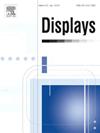Interpersonal synchronization and eye-tracking in children with autism spectrum disorder: A systematic review
IF 3.7
2区 工程技术
Q1 COMPUTER SCIENCE, HARDWARE & ARCHITECTURE
引用次数: 0
Abstract
Background:
We aimed at synthesizing recent literature on interpersonal synchronization (IPS) and eye tracking (ET) in children and adolescents with autism spectrum disorder (ASD) during face-to-face real-time social IPS tasks, how atypical their performance is compared to typically developing (TD) children, and at analyzing factors influencing eye movements, ET performance, patterns of cortical in ASD children.
Method:
Web of Science, PubMed, ScienceDirect, Embase and Cochrane Library databases were searched. The review is registered with PROSPERO (CRD42021245383).
Results:
11 of the 532 retrieved papers were included. 7 studies applied eye-tracking and 4 studies applied functional near infrared spectroscopy (fNIRS). Children with ASD were often characterized by atypical gaze patterns in the 7 eye tracking studies, that is, a marked decrease in the focus on the faces of adults and an increase in the focus on the backgrounds. In 4 fNIRS studies, children with ASD showed poor movement synchronization, hypoactivity of superior temporal sulcus (STS), inferior frontal gyrus (IFG), middle and inferior frontal gyri (MIFG), middle and superior temporal gyri (MSTG), and hyperactivity of inferior parietal lobe (IPL). The activation of STS, IFG, MIFG and MSTG were associated with social performance, communication performance and ASD severity.
Conclusion:
Recognizing the early atypical development of eye movements and function in STS, IFG, MIFG, MSTG and IPL in children with ASD is an important factor in how clinicians, therapists and social workers treat and intervene with this population. Although, for the time being, it is difficult to draw conclusions with a high level of evidence due to the heterogeneity within ASD, inconsistencies in study design and the lack of multicenter randomized controlled studies. At present, preliminary investigations of behavior and neurobiological markers of ASD children in real-time face-to-face social IPS tasks are underway. In addition, we analyze their relevant influencing factors, which can contribute to guide the design of more targeted experimental paradigms and intervention practice.
求助全文
约1分钟内获得全文
求助全文
来源期刊

Displays
工程技术-工程:电子与电气
CiteScore
4.60
自引率
25.60%
发文量
138
审稿时长
92 days
期刊介绍:
Displays is the international journal covering the research and development of display technology, its effective presentation and perception of information, and applications and systems including display-human interface.
Technical papers on practical developments in Displays technology provide an effective channel to promote greater understanding and cross-fertilization across the diverse disciplines of the Displays community. Original research papers solving ergonomics issues at the display-human interface advance effective presentation of information. Tutorial papers covering fundamentals intended for display technologies and human factor engineers new to the field will also occasionally featured.
 求助内容:
求助内容: 应助结果提醒方式:
应助结果提醒方式:


